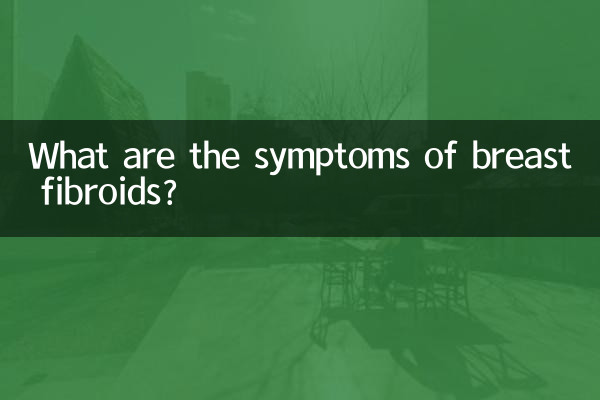What are the symptoms of breast fibroids?
Breast fibroma is one of the common benign breast tumors in women, mostly occurring in women aged 20-40 years. Although it is usually benign, understanding its symptoms and manifestations is crucial for early detection and treatment. The following is a detailed introduction to the symptoms of breast fibroids, combined with recent popular health topics on the Internet, to help women pay better attention to breast health.
1. Main symptoms of breast fibroids

| Symptoms | Description |
|---|---|
| breast lump | Most of them are single, round or oval, with clear boundaries, hard but movable texture, and no tenderness. |
| breast tenderness | Some patients may experience breast tenderness before the menstrual cycle, but this is not directly related to the lump. |
| skin changes | There are usually no skin depressions or orange peel-like changes (if they occur, be alert to the possibility of malignancy). |
| nipple discharge | Rarely, if accompanied by bloody discharge, further examination is required. |
2. The relationship between recent hot health topics and breast diseases
In the past 10 days, discussions about women’s health on the Internet have focused on the following aspects, among which breast health is one of the hot topics:
| hot topics | Related content |
|---|---|
| Breast cancer early screening | Hospitals in many places have promoted breast ultrasound combined with mammography, emphasizing the differential diagnosis of fibroids and breast cancer. |
| Lifestyle and Breast Health | Studies have shown that high-fat diet and staying up late may increase the risk of breast disease. It is recommended to have a balanced diet and regular work and rest. |
| Emotional stress management | Long-term anxiety or excessive stress will affect hormone levels and indirectly induce breast hyperplasia or fibroids. |
3. How to distinguish breast fibroids from other breast diseases?
Breast fibroids need to be differentiated from the following diseases. The key differences are as follows:
| disease type | Typical characteristics |
|---|---|
| Breast hyperplasia | The boundaries of the mass are unclear, often accompanied by periodic pain, and the texture is soft. |
| breast cancer | The mass is firm and immovable and may be accompanied by skin dimpling or axillary lymph node enlargement. |
| breast cyst | There is a fluctuating sensation on palpation, and cystic structures can be identified on ultrasonography. |
4. What should you do after discovering breast fibroids?
1.Regular follow-up: Review breast ultrasound every 3-6 months to observe changes in lumps.
2.avoid irritation: Reduce caffeine intake and wear well-fitting underwear.
3.surgical treatment: If the mass increases rapidly or the patient is under great psychological pressure, minimally invasive resection may be considered.
4.Traditional Chinese Medicine Conditioning: Some patients can relieve accompanying symptoms through traditional Chinese medicine that soothes the liver and regulates qi.
5. Summary
Although breast fibroids are mostly benign, women need to pay attention to their symptoms and actively manage their breast health in conjunction with recent health hotspots (such as screening and lifestyle adjustments). If an abnormal mass is found, you should seek medical treatment promptly for a clear diagnosis to avoid excessive anxiety but do not ignore the potential risks.

check the details

check the details